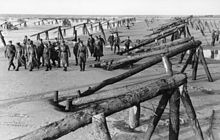Rommel's asparagus
[3] The term has also been used[4] to describe wooden logs set into the beaches of the English Channel and the Atlantic Ocean to disrupt amphibious landings of troops.In November 1943, when Rommel took command of the German Army Group B in occupied France, he also took control of the Atlantic Wall defenses on the French coasts facing the United Kingdom.He ordered machine gun crews to cover the exits of fields that were bounded by bocage—tall, dense hedgerows—so that glider infantry and paratroopers would come under fire as they moved out of their landing area.[2] Rommel reported after an inspection tour in April 1944[9] that "The construction of anti-paratroop obstacles has made great progress in many divisions.During Operation Tonga, the British airborne invasion of Normandy, Airspeed Horsa gliders landed among the wooden poles and suffered casualties.Accompanying the 82nd Airborne Division, Tito Moruza landed on D-Day with orders to don civilian clothing and make his way to Paris to seize Gestapo papers.[15] Once Allied troops were on the ground, some German units used the Rommelspargel for defense, by cutting them down and using the logs to reinforce impromptu positions.[16] On June 29, 1944, German General of Infantry Friedrich Wiese was put in command of the French Riviera, where it was expected that the Allies would conduct an invasion of Vichy France.[17] On August 15, Allied paratroopers and gliders of General Robert T. Frederick's mixed-nationality 1st Airborne Task Force landed in Operation Dragoon.An officer in the 551st, Major "Pappy" Herrmann, saw the damage inflicted upon the gliders by the wooden poles and concluded for himself "I'll stick to parachutes.



military glidersglider infantryGermanNormandyAlliedparatroopersairlanding infantryErwin Rommelinvasion of NormandyFrench RivieraEnglish Channelamphibious landingsArmy Group Boccupied FranceAtlantic Wallairborne forcestripwireshand grenadesteel railsbocageshellsTrafford Leigh-MalloryAllied Expeditionary Air ForceOperation TongaAirspeed HorsaSainte-Mère-ÉgliseAmerican airborne landings in Normandy82nd Airborne DivisionGestapo12th SS Panzer Division HitlerjugendVillons-les-BuissonsFriedrich WieseVichy FranceMarseilleRobert T. Frederick1st Airborne Task ForceOperation Dragoon551st Parachute Infantry BattalionDraguignanamphibious landingNeufchâtel-Hardelotlanding craftpile driverTeller mineEdward EllsbergSt. Martin's PressSouthern Illinois University PressSimon & SchusterOsprey PublishingWestern FrontWorld War IIOverlordNeptuneAtlanticBluecoatCharnwoodCapture of Caen and Orne bridgesFortitudeGoodwoodGreenline, Pomegranate and ExpressJupiterLüttichMallardMartletSpringTitanicTotalizeTractableWindsorBrévilleCarentanChamboisCherbourgMerville BatteryVerrières RidgeVillers-BocagePointe du HocAmerican logistics in the Normandy campaignBritish logistics in the Normandy campaignMulberry harbourOperation ChastityAmfrevilleAzevilleCrisbecqHoulgateLongues-sur-MerMervilleMont CanisyFalaise pocketHill 262Hillman FortressPegasus BridgeMilitary cemeteries in NormandyD-Day naval deceptionsDieppe RaidHobart's FunniesRhino tankAllied forces in NormandyLiberation of ParisOperation BodyguardOperation JedburghJune 6, 1944, order of the dayPeople of Western Europe speechWeather forecasting for Operation Overlord